The Correction Method of Water and Fresnel Reflection Coefficient for Soil Moisture Retrieved by CYGNSS
Abstract
1. Introduction
2. Study Area and Data Source
2.1. Study Area and Ground Measurements
2.2. CYGNSS Data
2.3. SMAP Data
2.4. Water Body Data
3. Methodology
3.1. Removal of Water
3.2. The Normalization of the Fresnel Reflection Coefficient
3.3. The Retrieval Algorithm of Soil Moisture
4. Results
4.1. The Correction Results of the Fresnel Reflection Coefficient
4.2. Estimation of Soil Moisture
4.3. Validation of Soil Moisture
5. Discussion
6. Conclusions
Author Contributions
Funding
Data Availability Statement
Conflicts of Interest
References
- Entekhabi, D.; Rodriguez-Iturbe, I.; Castelli, F. Mutual interaction of soil moisture state and atmospheric processes. J. Hydrol. 1996, 184, 3–17. [Google Scholar] [CrossRef]
- Entekhabi, D.; Asrar, G.R.; Betts, A.K.; Beven, K.J.; Bras, R.L.; Duffy, C.J.; Dunne, T.; Koster, R.D.; Lettenmaier, D.P.; McLaughlin, D.B.; et al. An agenda for land surface hydrology research and a call for the second international hydrological decade. Bull. Am. Meteorol. Soc. 1999, 80, 2043–2058. [Google Scholar] [CrossRef]
- Leese, J.; Jackson, T.; Pitman, A.; Dirmeyer, P. GEWEX/BAHC international workshop on soil moisture monitoring, analysis, and prediction for hydrometeorological and hydroclimatological applications. Bull. Am. Meteorol. Soc. 2001, 82, 1423–1430. [Google Scholar] [CrossRef]
- Shi, J.C.; Du, Y.; Du, J.Y.; Jiang, L.M.; Chai, L.N.; Mao, K.B.; Xu, P.; Ni, W.J.; Xiong, C.; Liu, Q.; et al. Progresses on microwave remote sensing of land surface parameters. Sci. China Earth Sci. 2012, 55, 1052–1078. [Google Scholar] [CrossRef]
- Bu, J.W.; Yu, K.G. Sea surface rainfall detection and intensity retrieval based on GNSS-reflectometry data from the CYGNSS mission. IEEE Trans. Geosci. Remote Sens. 2021, 60, 5802015. [Google Scholar] [CrossRef]
- Zhang, S.C.; Ma, Z.M.; Li, Z.M.; Zhang, P.F.; Liu, Q.; Nan, Y.; Zhang, J.J.; Hu, S.W.; Feng, Y.X.; Zhang, H.B. Using CYGNSS Data to Map Flood Inundation during the 2021 Extreme Precipitation in Henan Province, China. Remote Sens. 2021, 13, 5181. [Google Scholar] [CrossRef]
- Li, X.; Yang, D.; Yang, J.; Zheng, G.; Han, G.; Nan, Y.; Li, W. Analysis of coastal wind speed retrieval from CYGNSS mission using artificial neural network. Remote Sens. Environ. 2021, 260, 112454. [Google Scholar] [CrossRef]
- Guo, F.; Chen, W.J.; Zhu, Y.F.; Zhang, X.H. A GNSS-IR Soil Moisture Inversion Method Integrating Phase, Amplitude and Frequency. Geomat. Inf. Sci. Wuhan Univ. 2022, 1, 11. [Google Scholar]
- Ghiasi, Y.; Duguay, C.R.; Murfitt, J.; van der Sanden, J.J.; Thompson, A.; Drouin, H.; Prévost, C. Application of GNSS interferometric reflectometry for the estimation of lake ice thickness. Remote Sens. 2020, 12, 2721. [Google Scholar] [CrossRef]
- Ghiasi, Y.; Farzaneh, S.; Parvazi, K.; Duguay, C.R. Amplitue Estimation of Dominant Tidal Constituents Using Gnss Interferometric Reflectometry Technique. In Proceedings of the 2021 IEEE International Geoscience and Remote Sensing Symposium IGARSS, Brussels, Belgium, 11–16 July 2021; pp. 8546–8549. [Google Scholar]
- Chew, C.C.; Small, E.E. Soil moisture sensing using spaceborne GNSS reflections: Comparison of CYGNSS reflectivity to SMAP soil moisture. Geophys. Res. Lett. 2018, 45, 4049–4057. [Google Scholar] [CrossRef]
- Clarizia, M.P.; Pierdicca, N.; Costantini, F.; Floury, N. Analysis of CYGNSS data for soil moisture retrieval. IEEE J. Sel. Top. Appl. Earth Obs. Remote Sens. 2019, 12, 2227–2235. [Google Scholar] [CrossRef]
- Chen, S.Z.; Yan, Q.Y.; Jin, S.G.; Huang, W.M.; Chen, T.X.; Jia, Y.; Liu, S.C.; Cao, Q. Soil Moisture Retrieval from the CyGNSS Data Based on a Bilinear Regression. Remote Sens. 2022, 14, 1961. [Google Scholar] [CrossRef]
- Yan, Q.Y.; Huang, W.M.; Jin, S.G.; Jia, Y. Pan-tropical soil moisture mapping based on a three-layer model from CYGNSS GNSS-R data. Remote Sens. Environ. 2020, 247, 111944. [Google Scholar] [CrossRef]
- Eroglu, O.; Kurum, M.; Boyd, D.; Gurbuz, A.C. High spatio-temporal resolution CYGNSS soil moisture estimates using artificial neural networks. Remote Sens. 2019, 11, 2272. [Google Scholar] [CrossRef]
- Jia, Y.; Jin, S.G.; Chen, H.L.; Yan, Q.Y.; Savi, P.; Jin, Y.; Yuan, Y. Temporal-spatial soil moisture estimation from CYGNSS using machine learning regression with a preclassification approach. IEEE J. Sel. Top. Appl. Earth Obs. Remote Sens. 2021, 14, 4879–4893. [Google Scholar] [CrossRef]
- Hu, Y.F.; Wang, J.; Li, Z.H.; Peng, J.B. Land Surface Soil Moisture along Sichuan-Tibet Railway Corridor Retrieved by Spaceborne Global Navigation Satellite SystemReflectometry. Earth Sci. 2022, 47, 2058–2068. [Google Scholar]
- Nabi, M.M.; Senyurek, V.; Gurbuz, A.C.; Kurum, M. Deep Learning-Based Soil Moisture Retrieval in CONUS Using CYGNSS Delay–Doppler Maps. IEEE J. Sel. Top. Appl. Earth Obs. Remote Sens. 2022, 15, 6867–6881. [Google Scholar] [CrossRef]
- Chew, C.C.; Small, E.E. Description of the UCAR/CU soil moisture product. Remote Sens. 2020, 12, 1558. [Google Scholar] [CrossRef]
- Wan, W.; Ji, R.; Liu, B.J.; Li, H.; Zhu, S.Y. A two-step method to calibrate CYGNSS-derived land surface reflectivity for accurate soil moisture estimations. IEEE Geosci. Remote Sens. Lett. 2020, 19, 2500405. [Google Scholar] [CrossRef]
- Zhu, Y.F.; Guo, F.; Zhang, X.H. Effect of surface temperature on soil moisture retrieval using CYGNSS. Int. J. Appl. Earth Obs. Geoinf. 2022, 112, 102929. [Google Scholar] [CrossRef]
- Wu, X.R.; Ma, W.X.; Xia, J.M.; Bai, W.H.; Jin, S.G.; Calabia, A. Spaceborne GNSS-R soil moisture retrieval: Status, development opportunities, and challenges. Remote Sens. 2020, 13, 45. [Google Scholar] [CrossRef]
- Al-Khaldi, M.M.; Johnson, J.T.; O’Brien, A.J.; Balenzano, A.; Mattia, F. Time-series retrieval of soil moisture using CYGNSS. IEEE Trans. Geosci. Remote Sens. 2019, 57, 4322–4331. [Google Scholar] [CrossRef]
- Dobson, M.C.; Ulaby, F.T.; Hallikainen, M.T.; EI-rayes, M.A. Microwave dielectric behavior of wet soil part II: Dielectric mixing models. IEEE Trans. Geosci. Remote Sens. 1985, 23, 35–46. [Google Scholar] [CrossRef]
- Voosen, P. Satellites see hurricane winds despite military signal tweaks. Science 2019, 364, 1019. [Google Scholar] [CrossRef]
- Camps, A. Spatial Resolution in GNSS-R Under Coherent Scattering. IEEE Geosci. Remote Sens. Lett. 2020, 17, 32–36. [Google Scholar] [CrossRef]
- O’Neill, P.; Chan, S.; Njoku, E.; Jackson, T.; Bindlish, R. Algorithm Theoretical Basis Document L2 & L3 Soil Moisture (Passive) Data Products; Jet Propulsion Laboratory: Pasadena, CA, USA, 2014.
- Pekel, J.F.; Cottam, A.; Gorelick, N.; Belward, A.S. High-resolution mapping of global surface water and its long-term changes. Nature 2016, 540, 418–422. [Google Scholar] [CrossRef]
- Tsang, L.; Newton, R.W. Microwave emissions from soils with rough surfaces. J. Geophys. Res. Ocean. 1982, 87, 9017–9024. [Google Scholar] [CrossRef]
- Carreno-Luengo, H.; Luzi, G.; Crosetto, M. Sensitivity of CyGNSS bistatic reflectivity and SMAP microwave radiometry brightness temperature to geophysical parameters over land surfaces. IEEE J. Sel. Top. Appl. Earth Obs. Remote Sens. 2018, 12, 107–122. [Google Scholar] [CrossRef]
- Carreno-Luengo, H.; Luzi, G.; Crosetto, M. Above-ground biomass retrieval over tropical forests: A novel GNSS-R approach with CyGNSS. Remote Sens. 2020, 12, 1368. [Google Scholar] [CrossRef]
- Zavorotny, V.U.; Voronovich, A.G. Scattering of GPS signals from the ocean with wind remote sensing application. IEEE Trans. Geosci. Remote Sens. 2000, 38, 951–964. [Google Scholar] [CrossRef]
- Cui, C.; Xu, J.; Zeng, J.; Chen, K.; Bai, X.; Lu, H.; Chen, Q.; Zhao, T. Soil moisture mapping from satellites: An intercomparison of SMAP, SMOS, FY3B, AMSR2, and ESA CCI over two dense network regions at different spatial scales. Remote Sens. 2018, 10, 33. [Google Scholar] [CrossRef]
- Kim, H.; Parinussa, R.; Konings, A.G.; Wagner, W.; Cosh, M.H.; Lakshmi, V.; Zohaib, M.; Choi, M. Global-scale assessment and combination of SMAP with ASCAT (active) and AMSR2 (passive) soil moisture products. Remote Sens. Environ. 2018, 204, 260–275. [Google Scholar] [CrossRef]
- Ma, H.; Zeng, J.; Chen, N.; Zhang, X.; Cosh, M.H.; Wang, W. Satellite surface soil moisture from SMAP, SMOS, AMSR2 and ESA CCI: A comprehensive assessment using global ground-based observations. Remote Sens. Environ. 2019, 231, 111215. [Google Scholar] [CrossRef]
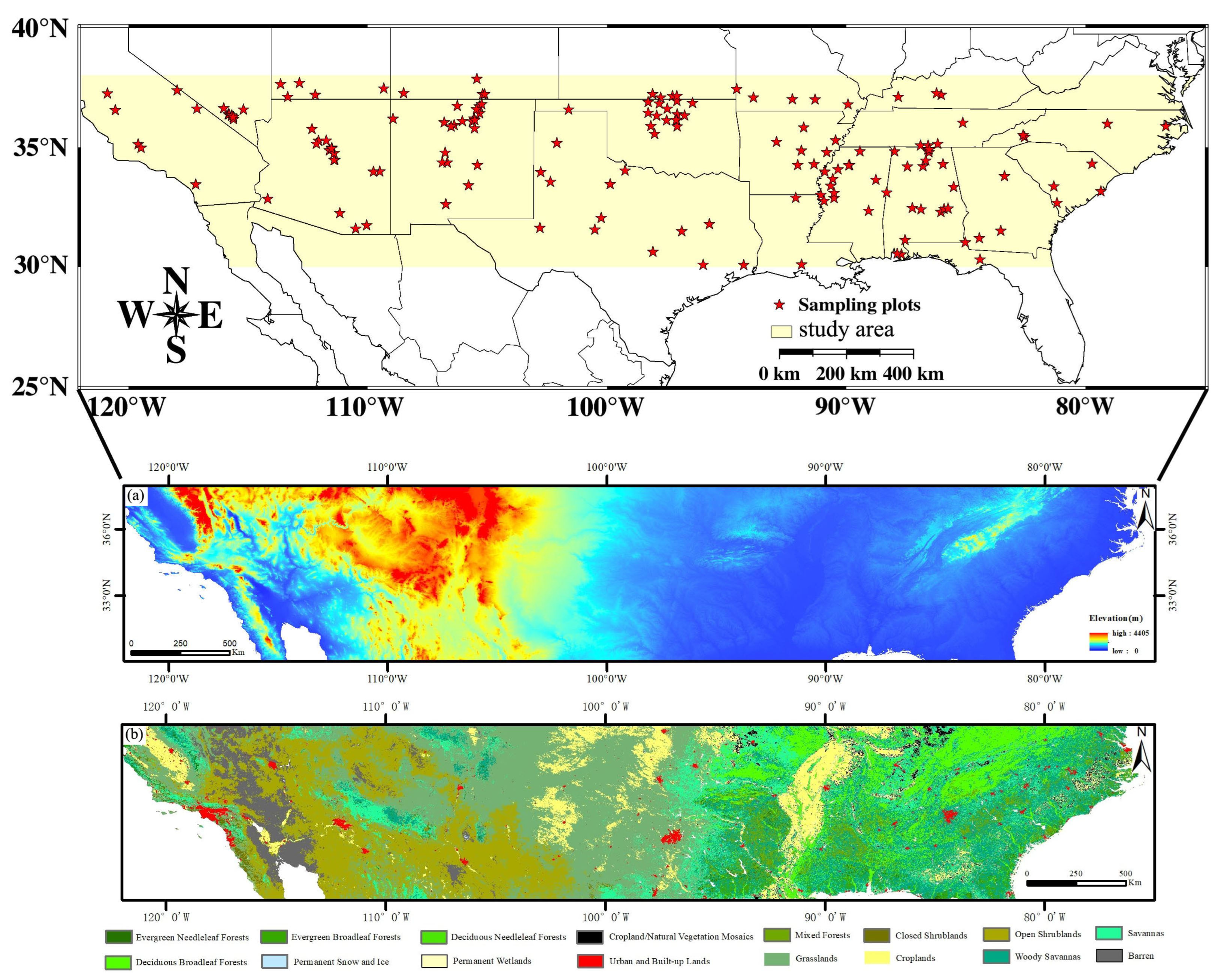

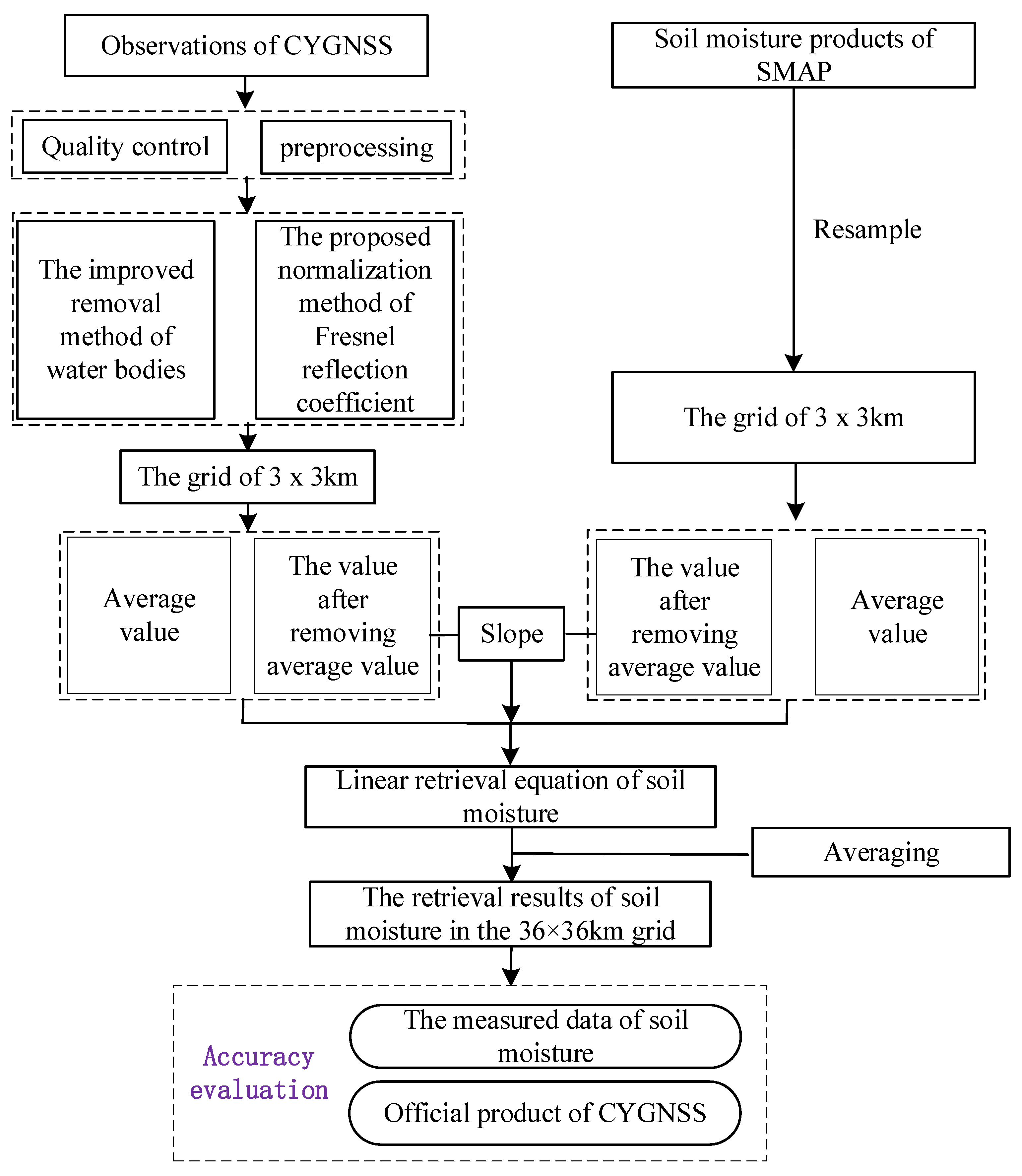


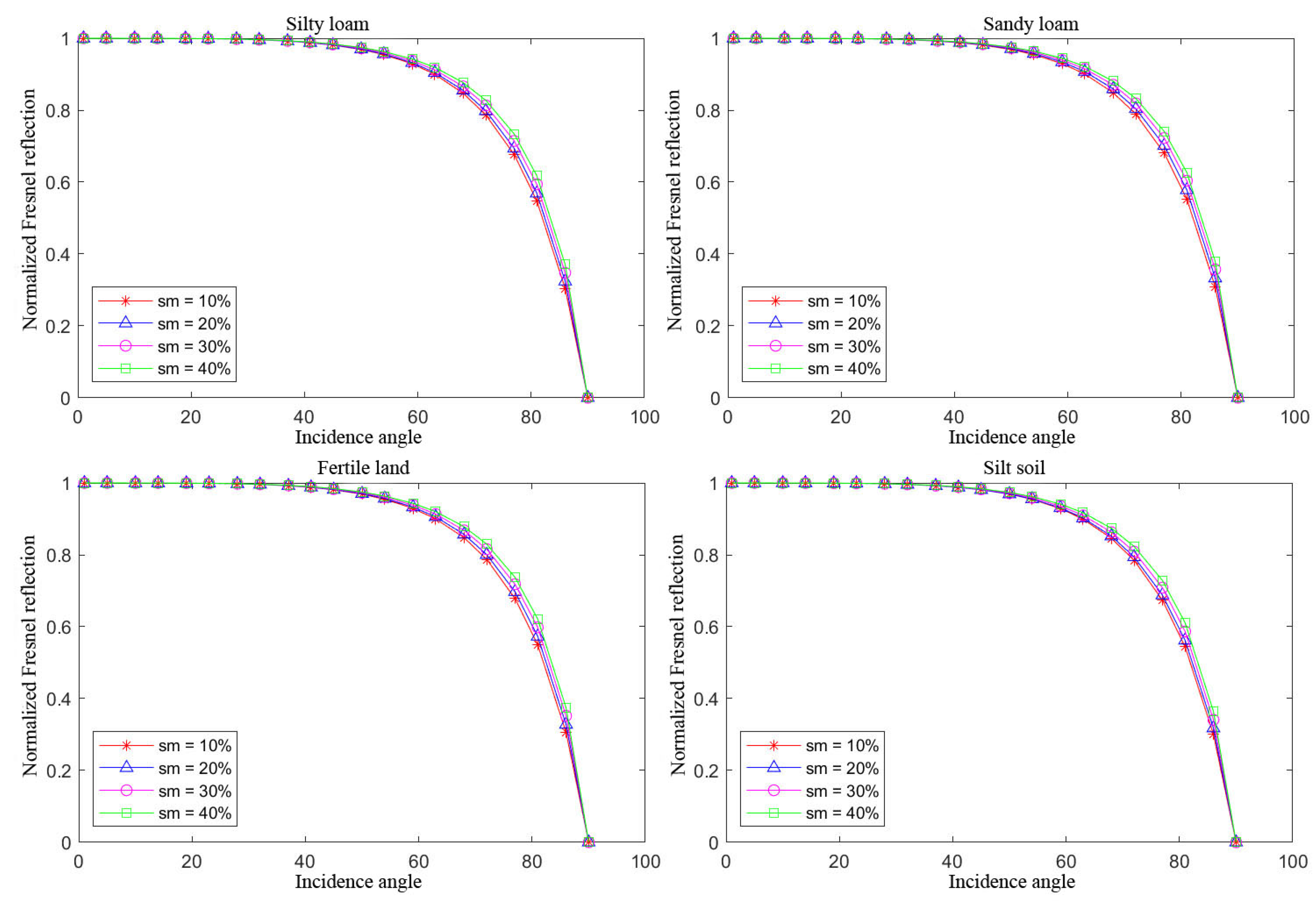
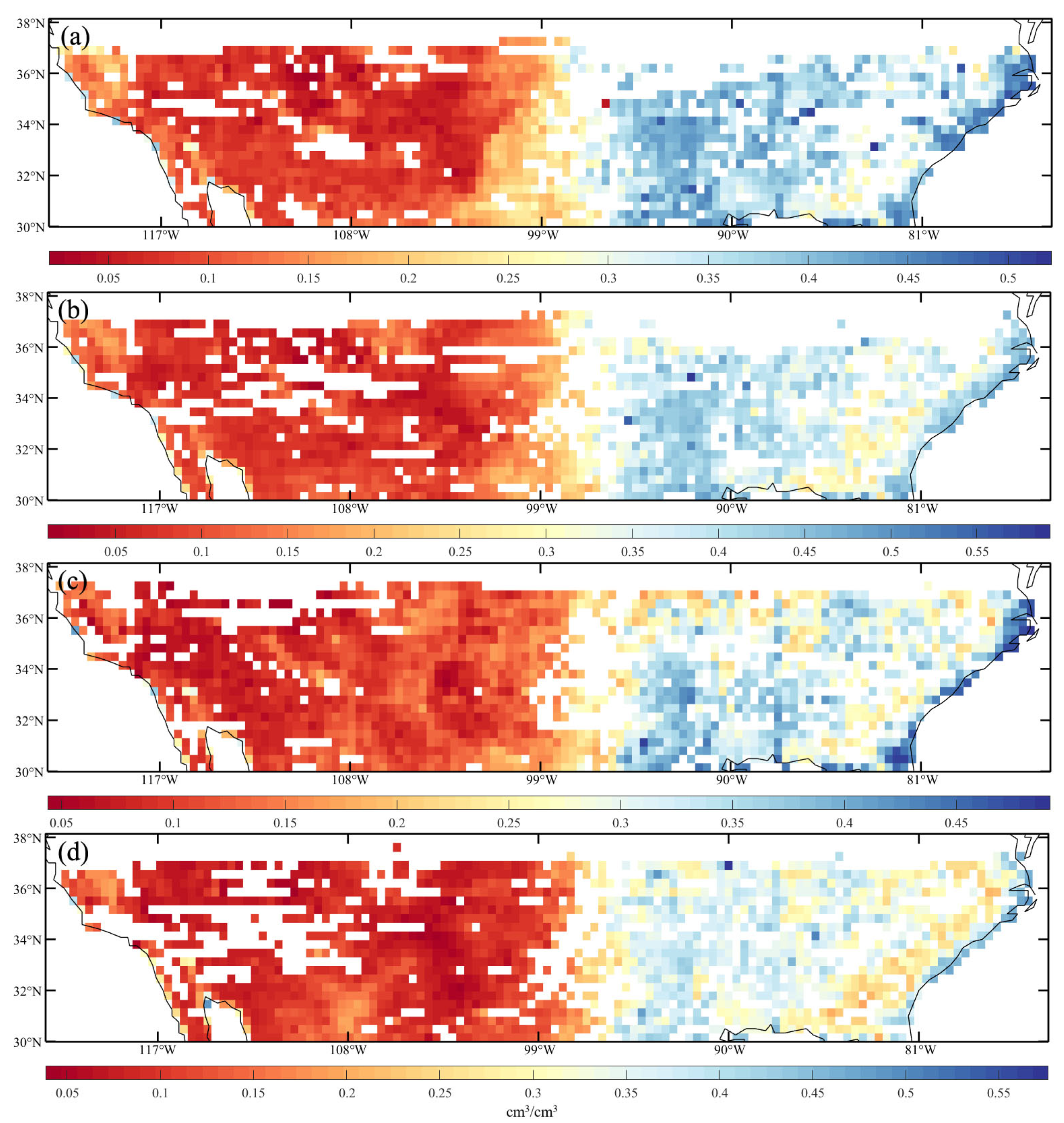
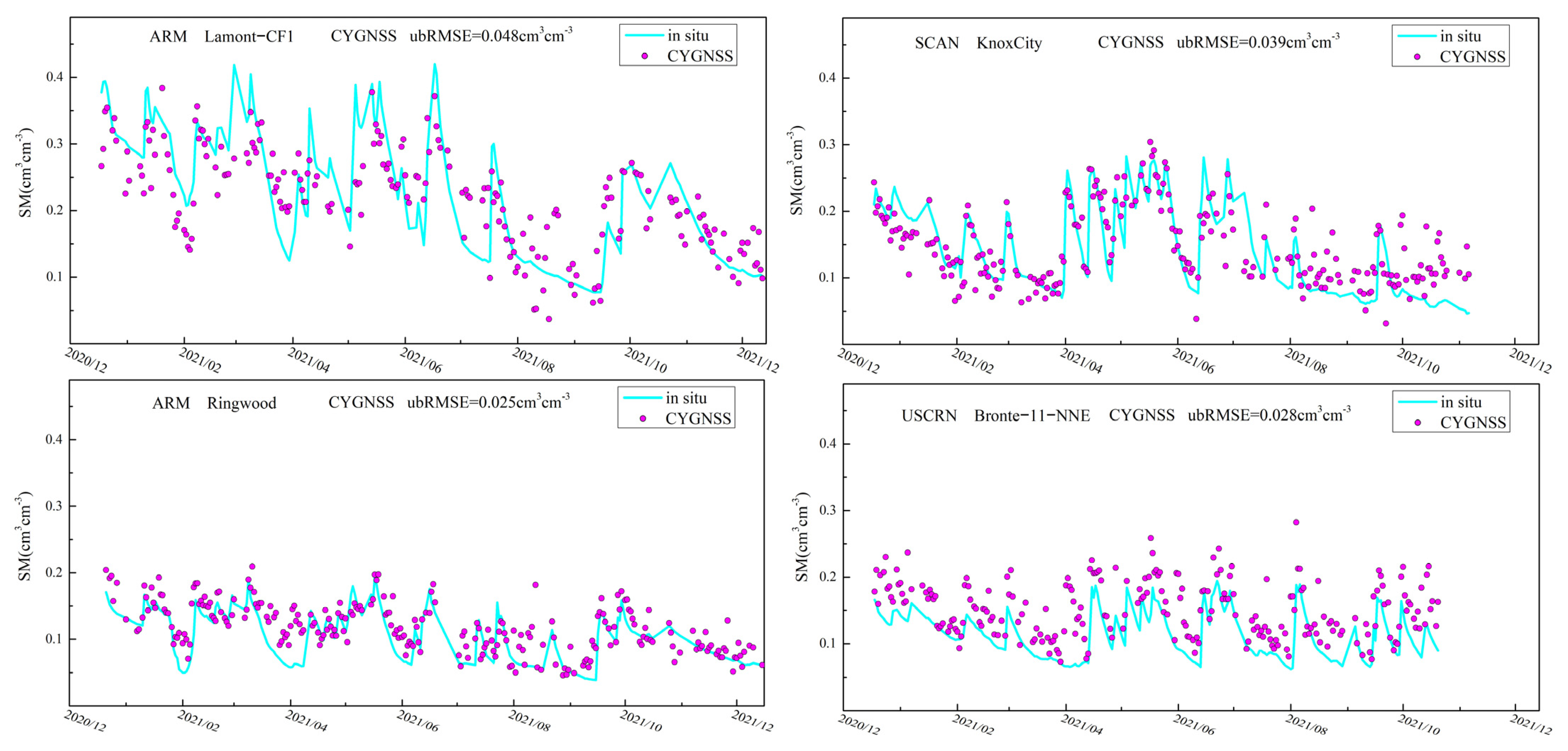



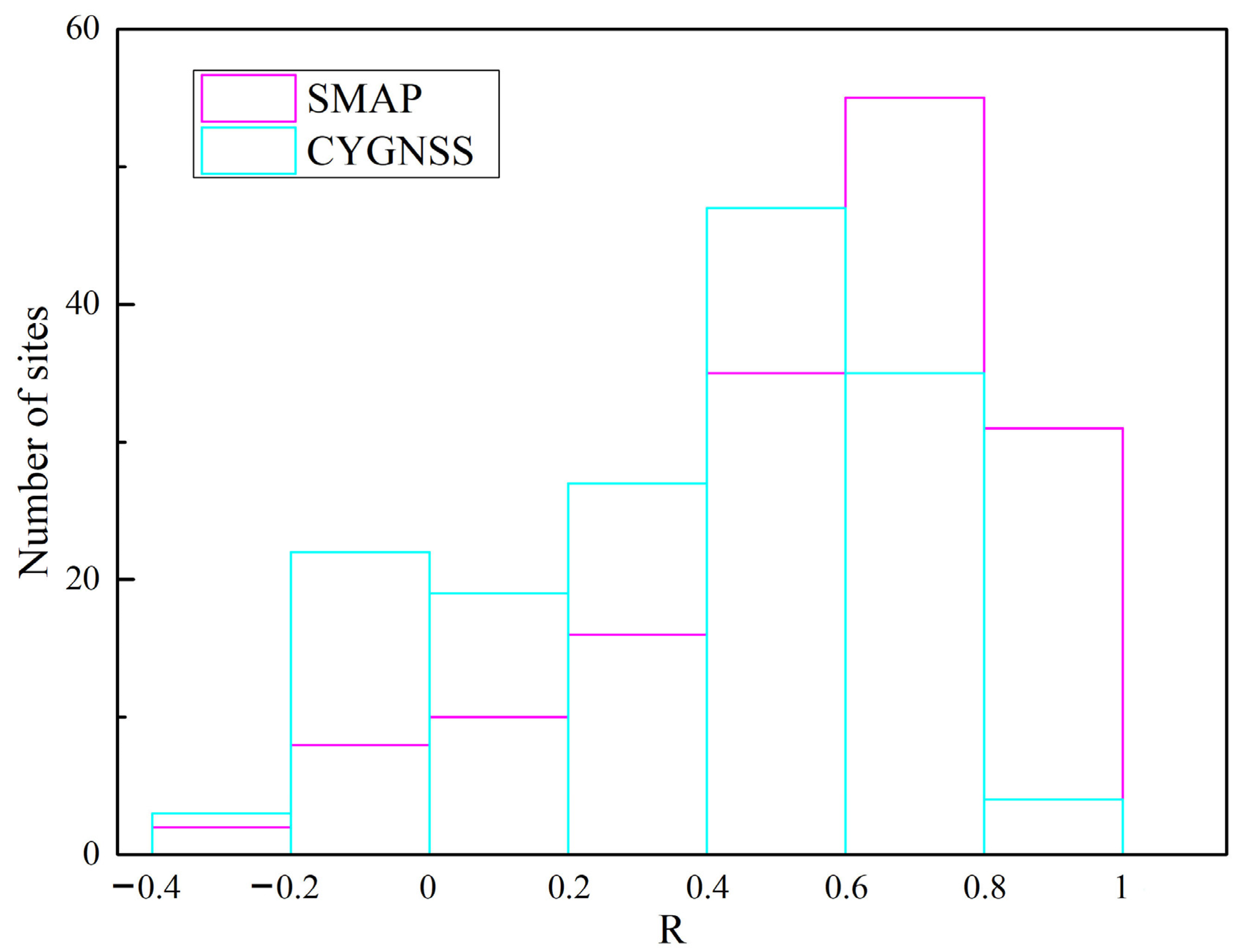
| Sandy Loam | Fertile Land | Silty Loam | Silt Soil | |
|---|---|---|---|---|
| Psand (%) | 51.52 | 41.96 | 30.63 | 5.02 |
| Pclay (%) | 13.42 | 8.53 | 13.48 | 47.38 |
| Psilt (%) | 35.06 | 49.51 | 55.89 | 47.6 |
| Ps | 2.66 | 2.7 | 2.59 | 2.56 |
| Pb (g/cm3) | 1.6006 | 1.5781 | 1.575 | 1.4758 |
| Number of Sites | ubRMSE (cm3/cm3) | |||||
|---|---|---|---|---|---|---|
| Median | Standard Deviation | Mean | ||||
| CYGNSS | SMAP | CYGNSS | SMAP | CYGNSS | SMAP | |
| ALL(160) | 0.057 | 0.051 | 0.026 | 0.024 | 0.061 | 0.056 |
| ARM(15) | 0.633 | 0.050 | 0.011 | 0.008 | 0.058 | 0.049 |
| SCAN(75) | 0.050 | 0.046 | 0.022 | 0.020 | 0.055 | 0.050 |
| SNOTEL(32) | 0.078 | 0.073 | 0.032 | 0.027 | 0.081 | 0.070 |
| USCRN(38) | 0.048 | 0.046 | 0.025 | 0.021 | 0.056 | 0.050 |
| Number of Sites | R | |||||
|---|---|---|---|---|---|---|
| Median | Standard Deviation | Mean | ||||
| CYGNSS | SMAP | CYGNSS | SMAP | CYGNSS | SMAP | |
| ALL(160) | 0.450 | 0.624 | 0.310 | 0.286 | 0.40 | 0.550 |
| ARM(15) | 0.710 | 0.828 | 0.110 | 0.063 | 0.677 | 0.824 |
| SCAN(75) | 0.457 | 0.624 | 0.278 | 0.288 | 0.380 | 0.558 |
| SNOTEL(32) | 0.241 | 0.366 | 0.291 | 0.264 | 0.180 | 0.300 |
| USCRN(38) | 0.510 | 0.670 | 0.226 | 0.191 | 0.440 | 0.638 |
| Number of Sites | ubRMSE (cm3/cm3) | |||||
|---|---|---|---|---|---|---|
| Median | Standard Deviation | Mean | ||||
| CYGNSS | UCAR/CU | CYGNSS | UCAR/CU | CYGNSS | UCAR/CU | |
| ALL(88) | 0.051 | 0.057 | 0.023 | 0.024 | 0.051 | 0.06 |
| SCAN(49) | 0.051 | 0.053 | 0.022 | 0.021 | 0.055 | 0.057 |
| SNOTEL(8) | 0.070 | 0.091 | 0.015 | 0.017 | 0.076 | 0.097 |
| USCRN(31) | 0.044 | 0.054 | 0.023 | 0.024 | 0.051 | 0.057 |
| Number of Sites | R | |||||
|---|---|---|---|---|---|---|
| Median | Standard Deviation | Mean | ||||
| CYGNSS | UCAR/CU | CYGNSS | UCAR/CU | CYGNSS | UCAR/CU | |
| ALL(88) | 0.467 | 0.510 | 0.250 | 0.236 | 0.410 | 0.470 |
| SCAN(49) | 0.488 | 0.600 | 0.246 | 0.200 | 0.427 | 0.500 |
| SNOTEL(8) | 0.126 | 0.095 | 0.242 | 0.191 | 0.131 | 0.186 |
| USCRN(31) | 0.500 | 0.470 | 0.224 | 0.233 | 0.440 | 0.457 |
Disclaimer/Publisher’s Note: The statements, opinions and data contained in all publications are solely those of the individual author(s) and contributor(s) and not of MDPI and/or the editor(s). MDPI and/or the editor(s) disclaim responsibility for any injury to people or property resulting from any ideas, methods, instructions or products referred to in the content. |
© 2023 by the authors. Licensee MDPI, Basel, Switzerland. This article is an open access article distributed under the terms and conditions of the Creative Commons Attribution (CC BY) license (https://creativecommons.org/licenses/by/4.0/).
Share and Cite
Wang, Q.; Sun, J.; Chang, X.; Jin, T.; Shang, J.; Liu, Z. The Correction Method of Water and Fresnel Reflection Coefficient for Soil Moisture Retrieved by CYGNSS. Remote Sens. 2023, 15, 3000. https://doi.org/10.3390/rs15123000
Wang Q, Sun J, Chang X, Jin T, Shang J, Liu Z. The Correction Method of Water and Fresnel Reflection Coefficient for Soil Moisture Retrieved by CYGNSS. Remote Sensing. 2023; 15(12):3000. https://doi.org/10.3390/rs15123000
Chicago/Turabian StyleWang, Qi, Jiaojiao Sun, Xin Chang, Taoyong Jin, Jinguang Shang, and Zhiyong Liu. 2023. "The Correction Method of Water and Fresnel Reflection Coefficient for Soil Moisture Retrieved by CYGNSS" Remote Sensing 15, no. 12: 3000. https://doi.org/10.3390/rs15123000
APA StyleWang, Q., Sun, J., Chang, X., Jin, T., Shang, J., & Liu, Z. (2023). The Correction Method of Water and Fresnel Reflection Coefficient for Soil Moisture Retrieved by CYGNSS. Remote Sensing, 15(12), 3000. https://doi.org/10.3390/rs15123000









